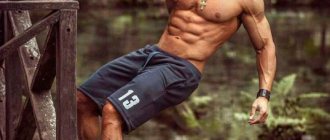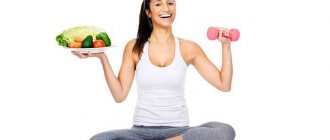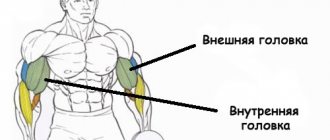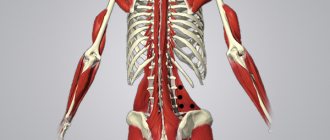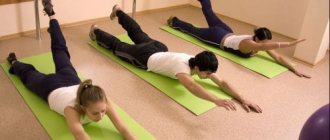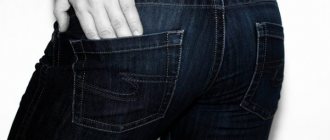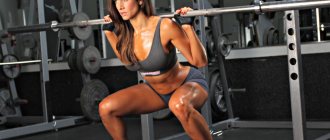Girls, women and men, as well as children of both sexes, jokingly boasting about their physical development, bend their arms and demonstrate their biceps. This habit indicates that even among people far from bodybuilding, biceps are traditionally considered the “king of muscles.”
Professional athletes also pay close attention to the biceps brachii muscle.
But to get a pair of great biceps, you don’t have to visit a professional gym - a program of exercises for biceps at home will help you save time, which is convenient not only for busy people, but also for those who like to exercise alone.
What is a biceps?
The full Russian name of the muscle is biceps brachii , and “biceps” is the abbreviated Latin name (bi in Latin means double).
The muscle is located on the front side of the humerus, and the main function of the biceps is to flex the arm at the elbow joint, but it is also involved in raising the arm forward by flexing the shoulder joint.
The upper part of the muscle is divided into two heads:
- Long;
- Short.
The long head is external, and the short one is internal. In the lower half of the muscle, the heads are connected to a belly, which passes into a tendon that attaches to the radius bone of the forearm. At the top of the biceps, the tendons of both heads attach to different parts of the scapula.
Is it possible to develop your hands at home?
Pumping up biceps does not require the largest weight of weights.
The average mass of projectiles is determined by:
- the small size of these muscles;
- isolated nature of exercises;
- the risk of injuring the biceps or its tendon when using excessively heavy weights.
Due to the unnecessary use of huge weights, the biceps brachii muscles can be effectively developed at home. The minimum arsenal for this would be a pair of collapsible dumbbells or even one dumbbell.
But it’s better to diversify your equipment by adding a not very heavy barbell and horizontal bar. A barbell designed for targeted pumping of arms does not require stands, so such a projectile, even when assembled, will not take up much space, and, if necessary, can be easily disassembled and put away for storage in an even more compact form.
The same set of weights is suitable for the neighbor of the biceps - the triceps. And using the highly effective principle of pumping up your arms using the super series “biceps + triceps” , home workouts can be further reduced in time. Therefore, training your arms at home is a rational solution.
What does biceps training do?
In bodybuilding, the biceps brachii muscles play not only an aesthetic role, but are also necessary for working in various deadlifts. The stronger your biceps, the more weight you can use to pump up your back. And, on the contrary, biceps that are lagging in strength do not allow you to use the weights necessary for training your back.
The biceps brachii muscles are trained not only by bodybuilders, but also by representatives of many sports where the arms are involved.
This is due to the work of the biceps in movements such as:
- various traction;
- jerks;
- pull-ups;
- climbing in mountaineering and applied sports;
- boxing punches, in which the biceps acts as a brake and prevents dislocation of the elbow joint;
- stabilization of the elbow during hitting and throwing sports equipment (ball, javelin, hammer, puck);
- stabilization during triceps work such as presses and cleans.
Diet is also important
The biceps should be developed along with the rest of the body, otherwise the figure will look disproportionate, and you will have to wait 6 months or more for results. A balanced menu will accelerate the growth of muscle mass, which necessarily contains:
- chicken breast;
- low-fat cottage cheese and fermented milk products;
- fish, mackerel and salmon are very healthy;
- brown unpolished rice (wild);
- oatmeal and other cereals that supply carbohydrates;
- vegetables, fresh and steamed;
- eggs, at least 2 per day, but 10 is possible;
- beef or turkey as sources of protein.
You should eat meat, vegetables, and cereals every day. Your diet should be carefully planned to ensure it is balanced and nutritious.
Features of biceps pumping
Despite the fact that biceps can be pumped up with dumbbells alone using isolated exercises, this can be done faster by including basic exercises in your training, which include:
- pull-ups on the bar with a narrow reverse grip;
- wide grip pull-ups;
- standing barbell curls;
- lying barbell curls;
- Bent-over barbell row with a reverse grip.
The muscle groups that are preferable to train on the same day as biceps are:
- back;
- triceps.
The back muscles are loaded during rows, in which the arm flexors, including the biceps, are actively involved. Therefore, after back exercises, the arm flexors are already warmed up and ready for targeted exercises.
And the advisability of joint training of triceps and biceps is due to the fact that these muscles are antagonists, that is, they work in a mutual opposition mode. The biceps muscle flexes the forearm at the elbow, and the triceps muscle extends it. This combination is effective for the growth of both biceps and triceps.
On another day with biceps, it is preferable to train the forearms , since the latter work hard in deadlifts, holding weights. And when the muscles of the forearms are warmed up, they can only be refined with specialized exercises at the end of the workout.
As for other muscle groups, classes for any of them can be done on the same day as biceps, depending on your weekly training schedule.
All exercises for biceps should be done smoothly without jerking in both directions. You cannot throw the weight down, no matter how much you would like to do this because of fatigue, but you need to carefully lower it. Jerking while lifting and throwing weights can cause injury to the biceps tendon!
Exercises on the horizontal bar
If there is a horizontal bar near your house or in the house, then proper pull-ups on it will also have a positive effect on the development of your biceps.
You can do pull-ups with either a direct or reverse grip. Number of repetitions: 10-15. Number of approaches: 3. If pull-ups become easy, there is no need to increase the number of repetitions; it is better to hang additional weight on your feet. To better pump your biceps, it is not recommended to fully straighten your arms when performing pull-ups. All the exercises mentioned here should be performed smoothly, without jerking. Then the muscle will be worked evenly and the result will not be long in coming. Soon you will become the proud owner of voluminous biceps. And, note that you can do this even at home, without visiting the gym.
How to train at home?
Rules for training at home:
- When training at home, it is more convenient and safer to use an athletic bench rather than other items for sitting and lying exercises. It would be ideal if the design of the bench allows for adjustment of the backrest angle. This option allows you to do not only curls with dumbbells while sitting, but also many exercises for other muscles.
- When using a horizontal bar, its fastening should be as reliable as possible , so that you can exercise not only with “your own” weight, but also safely use additional weights for pull-ups. Do not attach the horizontal bar to wooden, plasterboard or plasterboard surfaces. It is better if it is attached to a concrete or brick wall with several long anchors or dowels.
- Before training, be sure to warm up and stretch the muscles being trained. And after training, you need to do a cool-down and stretching.
- Smooth swings and arm rotations are suitable as a warm-up . First you need to perform rotations in the shoulder joints in both directions, then in the elbow and wrist joints. The hands should be clenched into a fist during swings.
- Stretching the biceps brachii muscles occurs along with stretching the pectoral muscles . You can stretch with each hand separately or with both hands at the same time. In the first option, you need to grab a stable object at chest level with one straightened hand and smoothly move forward, feeling the stretching of the muscles of the chest and biceps, stay in this position for a few seconds and return to the starting position. Do this several times for both hands. The second stretch option involves using support for each arm. This can be a doorway, when resting your hands at chest level on the doorframes and leaning forward, you can also stretch your biceps and chest muscles. Jerking and strong muscle strain should not be allowed. There should be no pain when stretching!
- After training, the same manipulations are performed. Cooling down and stretching after training is necessary to ensure that the muscles do not become “clogged” and gradually shorten as a result of intense contractions during strength training. This effect is best observed on the biceps, when an athlete standing in a calm state has his arms slightly bent at the elbows and not fully extended. This shouldn't happen. Even large and strong muscles must be functional, resilient and elastic.
Horizontal pull-ups
Even when I'm working on my back at the gym, I choose horizontal pull-ups.
You may have heard of the bent-over barbell row. You grab a barbell, bend over, and pull the barbell toward your chest. This is a good exercise if done properly. But if the weight is heavy, it becomes difficult to perform the exercise with proper technique.
Horizontal pull-ups solve this problem. The technique of performing this exercise is difficult to spoil; weights can be added without the risk of increasing the risk of injury.
In addition to the back, they are also a great workout for the biceps and core.
Watch the video training for this exercise and follow these instructions:
- Lie on the floor under a bar or table.
- Grab the bar or edge of the table so that your palms are facing away from you.
- Maintain tension in your abs to keep your body in a straight line.
- Pull your body up until your chest touches the bar or table.
- Then lower yourself.
Lightweight options:
- Pull at the doorway
- Traction with a rag
More complicated options:
- Horizontal pull-ups with increased leg support
- Horizontal pull-ups with weights (for example, a backpack)
Exercises with weights
Dumbbell Curl
The exercise is performed standing. In this position, the muscle corset does not relax and supports the spine, removing unwanted stress from it. But this does not mean that doing the exercise while standing is better than sitting. Both options have their advantages.
The technique of exercise with dumbbells differs from a similar exercise with a barbell in that:
- Allows the arms to work independently of each other, which is why each arm can be loaded 100%, even if they have slightly different strengths, you just need to do additional repetitions to failure with the arm that is possible;
- The hand can be rotated at different parts of the range of motion;
- You can do bends alternately with each hand.
Procedure:
choose the same weight for both dumbbells;- pick up dumbbells;
- stand straight with a distance between your feet approximately shoulder width apart;
- There is no need to slouch and raise your head up, your gaze should be directed forward;
- hands holding dumbbells hang freely near the hips;
- the hands can be turned with bent fingers inward, backward or forward;
- if the hands are turned inward, then they are on the sides of the hips, and when the hands are turned back or forward, they are in front of the hips;
- begin to smoothly lift the dumbbells with only your forearm, fixing your elbows;
- throughout the entire amplitude, the movement should be smooth and the elbows motionless;
- Having reached the highest point of the apparatus and maximum bending of the arm at the elbow, stay in this position for a couple of seconds and smoothly lower the dumbbells to the starting position;
- when lifting the weight, you need to exhale, and when lowering, inhale;
- do the required number of repetitions and approaches.
When performing the exercise with both hands at the same time, an involuntary tilt of the body back may occur, which means a harmful load on the lower back will occur. Therefore, it makes sense to do curls alternately with your left and right hands - in each approach, holding dumbbells in both hands, take turns lifting the weight, first with one hand and then with the other. In this option, the exercise will take a little longer, but this is not the case to save time on your health.
Curling your arms with dumbbells, unlike curling with a barbell, allows you to supinate or pronate your hands during the movement:
- Supination is the rotation of a limb around its axis counterclockwise for the left arm or leg, and clockwise for the right limbs;
- Pronation is the rotation of a limb along its axis in the direction opposite to supination.
When applied to the arms, wrist supination allows the biceps to contract as much as possible during the exercise, which makes the workout more intense. And pronation is needed to train the brachialis muscle, which is located under the biceps and, as it grows, seems to push out the biceps, which makes the arms visually larger in volume.
Dumbbell Hammer Raise
The exercise loads the biceps, shoulder muscles and a little brachioradialis. Due to the neutral position of the hand without full supination and pronation, when the clenched fingers are directed inward, this exercise is basic and not isolated, since it works not one, but several muscles.
Here the starting position is the same as the previous exercise. The only difference is in the position of the hands throughout the entire range of movement up and down. The advantage of the movement is that it is “basic”, which allows you to reduce training time compared to using isolated exercises for each muscle.
The disadvantage of the exercise is the incomplete contraction of the biceps and the non-maximum intensity of the work of the brachial muscle. But you shouldn’t give up the exercise, as it contributes in its own way to the harmonious and versatile development of the hands.
Exercises on the horizontal bar
Pull-ups on the bar are basic exercises. Although they work the latissimus dorsi muscles more, the exercises are great for pumping up the biceps, brachialis and brachioradialis muscles.
When performing pull-ups with a narrow reverse grip, when the clenched fingers are directed “towards you,” the biceps are loaded more than with a medium and wide grip with the clenched fingers “away from you.” But you can change the nature of the load on the biceps by using gymnastic rings attached to the bar and performing supination of the hands during pull-ups.
Supination will allow you to maximize the stretch and contraction of your biceps, which will increase the intensity of your workout. In the lower position, the hands should be directed with clenched fingers “away from you”, and as you pull up, the hands smoothly turn with your fingers “towards you”. While lowering the body down, the hands rotate along their axis in the opposite direction.
If there is insufficient load during pull-ups, you can use additional weights. This could be a barbell plate attached with a chain with a carabiner to an athletic belt.
With expander
This machine has a characteristic feature, unlike free weights and blocks, the more it is stretched, the more resistance it causes.
Because of this, in the final phase of bending the arm there will be the greatest load, and in the initial phase the load will be minimal. This nature of the load introduces variety into the process of physical impact on the muscles.
There are short expanders with which you can pump your biceps separately with each hand, and there are long ones that allow you to perform arm curls with both hands at the same time.
An exercise for biceps with a short expander looks like this:
- one handle of the simulator must be held with your foot, inserting your foot as deep as possible into the handle and stepping on it with your entire body weight;
- with the hand of the same name as the one holding the leg, grab the other handle;
- standing straight, begin to bend your arm at the elbow joint with your elbow motionless;
- bending your arm as much as possible, hold for a couple of seconds in the peak contraction of the biceps and smoothly straighten your arm to the starting position;
- do the same with the other hand, using the other leg to fix the lower handle.
It is necessary to ensure that the lower handle is securely fixed with the foot. When released while the expander is being stretched, the handle may hit and cause injury! The lower handle can also be hooked to a strong hook at the bottom of the wall, or by making a loop from the elastic bands of an expander, you can hook it to the bottom crossbar of the wall bars.
When using a long expander, you need to stand with both feet in the middle of the elastic bands or springs and perform arm curls simultaneously or alternately.
With any of these exercise variations, you can use supination or pronation of the hand simultaneously with flexion of the arm at the elbow to further contract the biceps or transfer the load to the shoulder muscles, respectively.
Lifting the bar
This exercise targets the biceps or shoulder muscles, depending on the type of grip. To train the biceps muscles, you need to take the bar from below, and to work out the shoulder muscles, you need to take it from above. Both exercises are important because they create overall arm volume.
Technique:
- The width of the hands when gripping from below can be varied from the narrowest to the widest. This allows you to work primarily on the outer and inner heads of the biceps, respectively.
- When lifting the barbell for biceps while standing , you should not tilt your torso back, as this can harm the lumbar spine. The up and down movement is smooth with a short pause at the highest point. When lifting, exhale; when lowering, inhale.
- The biceps curl can be done while lying on your stomach. To do this, you need a high bench so that your arms and the barbell hang freely and do not rest on the floor. This variation puts the load slightly on the upper biceps and shortens them more than any other exercise.
Seated arm curl
The exercise can be of two types:
- Concentrated curls with a dumbbell with one hand;
- Incline dumbbell curls.
In both versions of the exercise, you can supinate the hand while lifting the dumbbell and pronate when lowering it. The first option places a light emphasis on the upper part of the biceps, and the second option on the lower part. During incline curls, the biceps are stretched to their maximum.
Executing the first option:
- sit firmly on a bench with your feet wider than shoulder-width apart and your knees apart;
- take a dumbbell of the required weight in one hand;
- rest the elbow of the working hand on the inner thigh of the leg of the same name, closer to the knee;
- with the other hand you need to rest on the other thigh;
- the working arm with the dumbbell should hang down freely;
- smoothly bend your arm with a dumbbell, fixing your elbow and exhaling;
- hold the projectile at the peak point for a couple of seconds and smoothly lower it to the starting position, taking a breath;
- do the same with the other hand.
Second version of the exercise:
- set the back of the bench at approximately 45°;
- take dumbbells in both hands and sit on a bench, leaning your back on the back;
- the legs rest securely on the floor, helping to maintain stability and balance;
- hands with dumbbells hang freely on the sides of the back of the bench;
- at the same time, smoothly lift the dumbbells with both hands, bending your arms at the elbow joints and holding your elbows motionless;
- holding the dumbbells at the top point for a couple of seconds, smoothly lower them to the starting position;
- When lifting, you can supinate the hands.
Push-ups
Push-ups, like any presses, are basic exercises for the chest, triceps and deltoids. But since the biceps are antagonists to the triceps, push-ups act on the biceps muscles, forcing them to do stabilizing work.
Push-ups can be slightly modified to vary the load. Here are some variations of this exercise:
- push-ups with narrow arms;
- push-ups with wide arms;
- Push-ups with your feet elevated.
In addition, all these options can be performed with fists, which will involve the muscles and ligaments of the forearm.
Features of the exercises:
- A variation with a narrow stance is quite problematic to do with support on the palms, so support on the fists will be the best option here. When you rest your feet on the floor, the middle and lower bundles of the pectoral muscles work, and when you place your legs high on the bench, the load transfers to the upper bundles of the chest.
- By keeping your hands close to each other , the athlete creates more stress on the triceps, and if you place your hands wide, the pectoral muscles will do most of the work.
- When the elbows are pulled back , more load is transferred to the triceps and anterior deltoids, and when the elbows are pulled to the sides, the chest is loaded more. When going down, you need to inhale, when going up, exhale.
- If the goal is to build muscle , then the movements during push-ups should be smooth in both directions. If necessary, you can use additional weights in the form of a barbell plate tied to your back or a backpack with a load. You can also have a training partner apply pressure to your upper back or even sit on it, creating additional stress.
Working out biceps in the gym
As a rule, work in the gym is easier and the results come faster due to the fact that here you will perform not 3-4 exercises, but much more.
You will use various devices to work not only the entire muscle, but also focus on its different parts. A good trainer can help organize highly effective training and will always provide backup. In the gym, you can perform concentrated biceps curls with maximum weights, which is strictly not recommended to be done at home. Always remember that if your goal is to effectively work your muscles, then perform the exercises without cheating.
Lifting the bar
Unlike at home, where it is not recommended to work with heavy weights, since at home there may be no rack and no one to support you, in the gym you can give it your all. The standing barbell curl is a basic biceps exercise. It is considered one of the most effective for increasing the volume and strength of the biceps.
You need to grab the barbell at shoulder width, with an underhand grip. By contracting the biceps, the projectile rises. You need to make sure that your elbows do not move forward. Typically, this happens when the athlete tries to lift the barbell higher. This should not be done, as the load will transfer from the biceps to the deltoids.
Arm curl while sitting on an incline bench
To perform this exercise, you need to sit on an incline bench and pick up dumbbells. Your feet should be pressed firmly to the floor and your back should be against the back of the bench. The arms should be bent alternately at the elbow joints, lifting the dumbbells. In the upper position, you need to turn your hands towards yourself as much as possible. Elbows should not be pushed forward.
Working with a barbell on a Scott bench
The barbell should be held with a reverse medium grip.
It is with this grip that the biceps will be worked out best. Shoulders should be supported. In this position, the load falls only on the biceps. This exercise is especially effective at pumping up the lower biceps. If you feel excessive tension in the wrist joints, you can use a barbell with a curved bar. Alternatively, you can use a Scott bench to perform biceps exercises with dumbbells.
Number of repetitions: 8-12. Number of approaches: 3.
Basic biceps exercises were given that can be performed without the use of exercise equipment. But if it is possible to use these devices, it must be done.
Exercises with simulators
Bending arms on a machine using a lower block
In addition to free weights, you can use exercise machines at home for training, if possible. There is a large selection of such devices on sale.
The effect of blocks on muscles is slightly different from the nature of the load of dumbbells and barbells. The combination of free weights and blocks has a beneficial effect on the harmonious development of muscles.
The biceps machine with a lower block is similar to a Scott bench. But the simulator provides a constant load at any point in the range of motion, and when using a Scott bench and a barbell, the load on the biceps disappears in the upper phase of the movement.
Therefore, a machine with a lower block is preferable to a Scott bench, but when using it, weights should not be abused, since due to the constant load along the entire path of the forearm, there is a risk of injury to the biceps tendon.
Crossover Curl
A crossover is a machine with two symmetrical blocks, each of which consists of a cable, a handle and weights. This device can train almost any muscle, but it is precisely because of the exercises on the chest and deltas that it is called a crossover, since the arms are crossed during these movements (cross in English).
The crossover can be top or bottom. The upper one is when the block or wheel is located on top, and the lower one is located on the bottom. Biceps can be trained with both upper and lower crossovers. During the exercise, the elbows should be motionless and directed to the sides.
Features of the exercises:
- You can pull both blocks simultaneously with different hands, or with each hand separately. When using an upper crossover, the biceps will contract more, and when working on a lower crossover, the biceps will stretch more. Therefore, both options need to be varied.
- If you pull one block with both hands, then the upper option will be analogous to lifting a barbell for biceps while lying on your stomach, since it creates a similar load angle. The lower block will create an analogue of a standing biceps curl.
- The starting position when training both biceps using one lower block is the same as when lifting a barbell for biceps while standing. You cannot tilt your body back. Movements are smooth in both directions. To change the angle of the load, you can stand closer to the block, further away, or do the exercise while lying down.
Dumbbell biceps curl
Lifting dumbbells for biceps is a basic exercise for training biceps. Unlike the barbell, you can perform this exercise with external rotation of the wrist (supination). Due to this, the shoulder and brachioradialis muscles are included in the work.
Initial position:
Take dumbbells of the required weight. The palms can be facing each other (neutral grip - puts more strain on the brachialis muscle) or palms up (regular grip).
Technique:
Option 1. We pump the biceps with a neutral grip.
- At the start, arms are lowered down, palms facing each other.
- As you exhale, bend your elbows and turn your hands outward, with your palms facing your chest at the top.
- As you inhale, straighten your arms, returning to the starting position.
Option 2. We pump up the biceps with a regular grip.
- At the start, arms are down, palms are facing up.
- As you exhale, bend your elbows.
- As you inhale, straighten your arms, returning to the starting position.
In both versions of the exercise, dumbbells can be lifted both simultaneously or alternately (lowering the right hand, raising the left).
We recommend alternating variations of the exercise. For example, in the first workout, lift dumbbells with a neutral grip (option 1), and in the second workout, pump up your biceps with a regular grip (option 2).
You can also change the methods of lifting dumbbells for biceps from time to time. For example, in the first workout, raise both arms at the same time, and in the second, pump up your biceps by alternately lifting your arms. This way you will not let your muscles get used to monotonous exercises and will achieve better results.
Perform: 3-4 sets of 10-14 repetitions.
Training frequency and number of repetitions
- Depending on the individual characteristics of the body, the recovery period between biceps workouts can be from 2 to 4 days. The recovery period for biceps can be determined by noticing how long it takes for the muscles to completely stop hurting after training. Only after the pain has completely stopped can you start a new workout. As a rule, biceps are pumped 1-2 times a week.
- The biceps brachii muscle grows under the influence of an average number of repetitions of 8-12 times per set . Doing fewer repetitions by increasing the weight of the weight is not advisable, as this can lead to injury.
- When starting training, you need to do 1 approach, in the second month 2 approaches, and starting from the third month increase the number of approaches to three . This number is enough even for experienced athletes.
- In each biceps workout, you need to perform two exercises. The right set of exercises at home will provide a variety of muscle loads. And also for this, experienced athletes can change exercises every 3 workouts, and beginners every 5-10 sessions.
Alexandrova Anastasia
Nutrition and healthy lifestyle specialist and author of myfitnesblog.com. For many years, she has successfully helped women and men lose weight and maintain a beautiful figure.
What to consider
- Beginners are advised to keep a diary so as not to forget to train and constantly monitor their progress.
- To grow muscles, you should sleep at least 8 hours a day.
- Movements should be varied. You should do about 5 different exercises in one workout.
- You cannot trust sources that promise instant results. Biceps growth depends on the individual characteristics of the body and the amount of training. Muscles will never become voluminous and prominent in a week or even a month.
The main rule of an athlete who wants to have beautiful biceps is training, intense and regular. At first it will be difficult to overcome your own laziness, change your diet and constantly exercise, but the results are worth all the effort.

